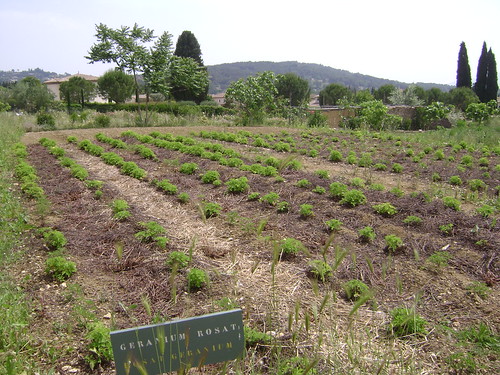Rose Geranium Field
In the past year I’ve been quite obsessed with geranium. This seemingly simple, familiar note is far more interesting than I’ve expected, and if it wasn’t for a few exquisite samples that I have received from Eden Botanicals at the time, I probably would have gone about my ways completely overlooking its potential as a centerpiece in a composition, let alone treat it as an interesting perfume material.
Geranium is a very important and useful note in perfumery, but usually plays only a supporting role: its high contents of geraniol, citronellol (both present at very high ratio in rose oil and absolute) makes it a perfect rose extender. It is nearly considered “a poor man’s rose” as it is far less expensive than any rose oil or absolute.
All geranium oils (including what is commonly referred to as "rose geranium") is extracted from the entire plant, not the flowers. The leaves and flowering tips of fragrant geranium varities are all harvested for distillation. In fact, even the branches are fragrant. And appropriately so, the oil has both floral and leafy elements, which is what makes it such a versatile and important perfumery raw material.
Geranium is marvelous in fruity accords, where it adds body and wine-like sweetness. And its minty aspect (from menthone and isomenthone) is what makes geranium a perfect team player in leafy-green, fougere, herbaceous, citrusy and cologne-type fragrances. Although I have used gerainum extensively throughout my collection) it was never the centrepiece.
One challenge with geranium is that it is ever so potent. A little goes a very long way and it can easily overwhelm a formula. But that can be seen as an advantage too! Also, it is relatively more simple than rose, so it’s easier to use geranium in a formula that requires a rosy element without cluttering it. Rose is far more difficult to work with than rose geranium – it poses a great challenge of walking on a tightrope between having too little to be noticed and too much elements that creates “mud” instead of a clear statement in a perfume.
The reason for this attitude of mine was not because I didn’t like geranium. On the contrary. I love the smell of fresh geranium leaves and whenever I pass a plant I borrow a leaf and crush it between my fingers. However, for some unknown reason, it does not seem to work very well on my skin when it is in high dosage, and I can’t really explain why. So this is perhaps one of my greater biases that stopped me from exploring what else can be done with geranium.
But after testing a few very fine geraniums (which I will discuss shortly), I felt immensely inspired to start working with this raw material more “seriously” so to speak. And my experiments I will explore with you here over the pages of SmellyBlog over the next few weeks. A very suitable topic for summer, since geranium has such an open, summery feel about it.
The species most commonly and widely used in perfumery is Pelargonium graveolens. I’ve received two excellent samples of this species, one grown in the Bourbon islands (aka geranium Bourbon) and the other grown on the Himalayas in India.
Geranium Bourbon
This variety is rosy and candy-sweet. Although it is considered second only to “African Geranium” (this is the common name for the now very scarce Algerian Geranium), I’m afraid to admit that generally it is my least favourite of them all. It can be a little too sweet, bordering on candy. This particular geranium though, although still detectably candy-sweet, was very much to my liking. It is very full-bodied and wine-like, and develops into a woody dryout, with hints of green. For some reason it reminds me of the Mediterranean beach I used to go to growing up in Israel (it’s called “Banana Beach” and is up north between Nahariya and Rosh HaNikrah, if you’re ever in the area you must go – it’s one of the most beautiful beaches in Israel!).
Himalayan Geranium
Opens very rosy, fresh like crushed leaves, lightly floral, but also full-bodied and smooth with sweet herbal, minty, green undertones and a slightly powdery dry out. At certain phases it actually reminded me of Himalayan cedarwood, with the same clean, woody and smooth texture.
Madagascar Geranium
This beautiful organically-grown geranium is from the species Pelargonium roseum. It is more complex, warm, a little spicy even and very rose-like and sweet. It develops into a powdery, ambery and heavy rose, and remains complex and well-balanced. The final dryout is a little more fresh and lemony, while remaining rosy and rich.
Egyptian Geranium
Also organically grown, but from another species Pelargonium x asparum, this oil is completely different from the typical “Rose Geranium”. It begins fuzzy, like freshly picked geranium leaves. Very realistic, in fact. It’s simultaneously rosy, green and powdery but a little sharp with perceiveable musky undertones. Its dryout is lemony as well as grassy and earthy.
If there is one thing I learned from my visit to Grasse was to appreciate even more the simplest, most common natural raw materials. There is always something new to explore about them, discover new ways to unveil this aspect or another.
Labels: Decoding Obscure Notes, Geranium, Rose Geranium




1 Comments:
Hmmm, smells good ;-)
Where is this Geraniums Field?
Post a Comment
<< Home